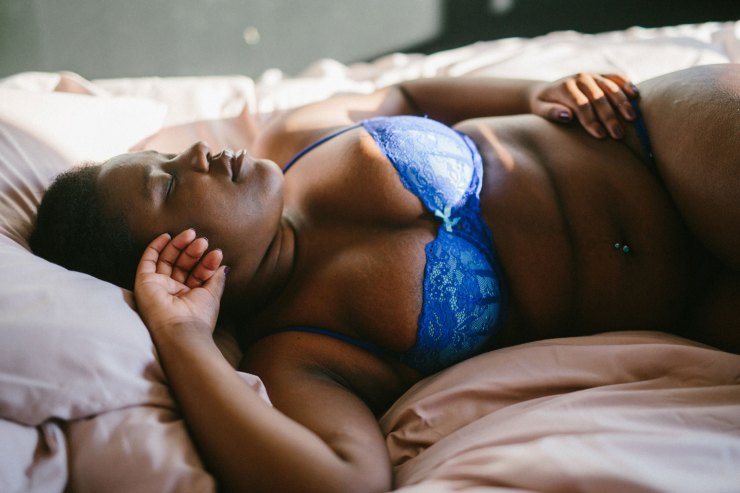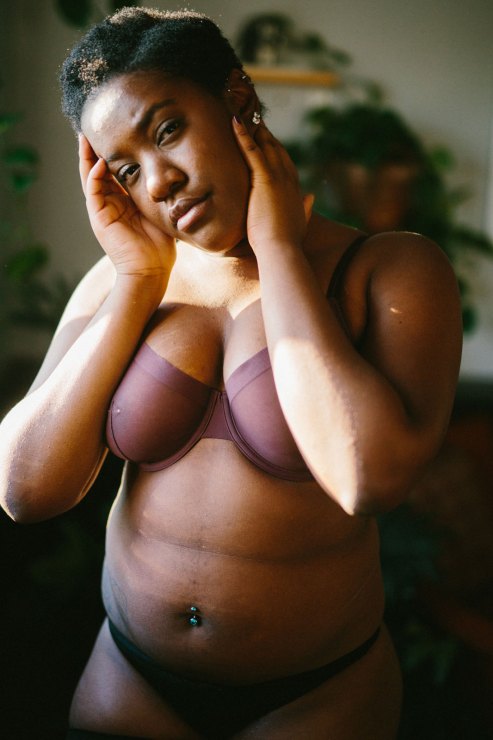Content warning: Mention of transphobia.
Boudoir photography is changing. It’s 2021 and the trans/gender-nonconforming people of the world are here to stay! Just the other day, Dictionary.com gave a huge shoutout to singular they/them pronouns.
Elliot Page is living his best life inside of his gender-affirmed body of choice. It’s time for boudoir photographers to join the table of common knowledge and educate themselves on how to be not just inclusive, but also a gender-affirming boudoir space.
My name is Ez and I use they/them pronouns. I’ve been out of the closet as a trans agender nonbinary person for nearly six years. Since coming out, I’ve made it my journey to be very loud and vocal about the things we can do to be better toward trans people. I’ve been a boudoir photographer for eight years and my brand is centered around queer inclusion. Additionally, I am a private mentor and public educator in the boudoir community who teaches regularly on these topics.

What does gender have to do with boudoir? This is the big question I get. Similar to why women hype up their femininity, we trans people want to lean into our own gender expressions and identity. Trans people can rarely celebrate their gender publicly. Many of us live inside of un-transitioned bodies due to systemic oppression making it impossible to transition without say, losing our spouse or apartment or job.
Only 21 states have protections against job discrimination of transgender and nonbinary people. It is 100% legal to discriminate against transgender people in housing, employment and denial of medical care in many states to this day.
Why do we need to include all marginalized genders in boudoir photography?
It’s a complex question that I’m going to breakdown for you. The short answer is that this is the right thing to do to be welcoming of all bodies. So many of us are marketing our boudoir brands to ALL bodies without doing the work to make sure all bodies feel safe in our spaces. Or represented on your website or Instagram.
I’ve devised some quick tips to start the process of including transgender, nonbinary and metagender people in your spaces.
1. Unlearn masculinity as something only for men
Masculine presentations are often assumed to default to looking like a man. When in reality, masculinity isn’t something to fear or link solely to men. There are butch lesbians out there living in masculine bodies. There are trans women who embrace their masculine features as a radical acceptance practice.
Nonbinary people who were AMAB (assigned male at birth) don’t always transition into feminine expression. But that doesn’t mean they are men. This doesn’t mean they are suddenly unsafe and threatening to your women members.
In fact, seeing nonbinary people who are feminine as “safer” is stigmatizing our poor AMAB nonbinary siblings. And categorizing them in with men, which they are not. If you see someone as one gender, when they’re telling you they aren’t that gender, you are being transphobic.

2. Remove gendered language from your everyday vocabulary
Gendered language is determined by each individual trans person in the room because they are the ones who are at risk of harm. Some might be OK with dude, while a trans woman might find that highly dysphoric. It can cause them mental harm (Gender Dysphoria) to hear themselves being called dude in whatever context or intent.
I am someone who doesn’t like any gendered language, even “gender-neutral” language causes me discomfort and distress. Below is a small list of terms I’ll encounter in groups.
Avoid using:
- Hey girl!
- What’s up man!
- Hello ladies and gentlemen
- Hey guys!
- Hey there babes
Try out:
- Hey everyone!
- Howdy ya’ll
- What’s up friend?
- Hey pal!
- Greetings to all!
Another trick to help unlearn gendered language is to refer to people you do not know the gender of a person versus assuming they are a woman or man. We cannot tell if someone who is a trans person is a man or woman or neither based on their outward appearance. Many are not transitioning for safety, many cannot afford tens of thousands in gender-affirming surgery and the majority don’t have access to jobs without dressing in cis binary ways. Some people just plain ol don’t want to transition, and that is fair too!

3. Pronouns must be normalized and respected regardless of your discomfort
A lot of the microaggressions that I experience daily are misgendering me or refusing to use my pronouns. It’s all fun and games for cis people to “debate” whether or not they/them is plural with me until I tell them they/them has been in singular use since Shakespearean times. Because it’s never really about them being plural at all. It’s just transphobia, and the unwillingness to accommodate trans people, that spark these “debates” over my humanity.
It is very, very difficult NOT to get upset when someone starts this age-old conversation that usually ends with me having to leave the space or asking someone to make them leave. Which happened recently at a dear friend’s party.
I was forced to leave after a cis person refused/argued against use my “plural” “confusing” pronouns when I asked for her to use them politely. I spent 20 minutes educating her as I would any mentee of mine, with patience and kindness. Very aware of offending her, I walked on eggshells! Still? She refused and doubled down on her transphobic behavior. I was chastised for not accepting her apology after her insistence that this was just a misunderstanding. She managed to convince all the other guests and my best friend that I was just having a bad mental health episode and gaslighted me by saying she never argued with me at all.
The results of this event caused me to enter a depressive low with suicidal ideation.

If you feel empathy for me? Know that it gets much worse for others with more intersections of oppression. I am a white trans person; Black/Indigenous trans women see the most violence in our community.
This is why using pronouns isn’t an option if you want to consider yourself an ally. It’s not a debate topic that is acceptable anymore. It is basic common decency.
When a trans person tells you that a cis person is being transphobic; believe them first. When a trans person tells you your group isn’t safe? Believe them. Do not get defensive. They live inside of their body as a trans person. Who else knows transphobia better? People who experience it first hand or the people who only learn secondly?
Educate yourself
Unlearning transphobia is a process we need to start working on but these steps will help you learn how to do better in your group as well as your personal life.
This fall, I will be releasing a comprehensive guide for creating a gender-affirming boudoir business. It will be the sum of my knowledge on how to create a safer space. It won’t be cheap, but it will change the entire way you run the ropes. Follow my Instagram for updates on its release.
Editor’s Note: We welcome this guest post by Ez Powers. Ez (ze/zem) is a trans educator, wedding, and boudoir photographer. Ze are located in Chicago, Illinois. Ze have spoken at festivals abroad about their fine art nude photography project. Ze currently mentors fellow boudoir photographers on disability and queer inclusion. Zyr passion lies within the psychology of self-esteem, trauma therapy fueled social work and invisible disability activism. You can find Ez at www.ezpowers.com and on Instagram.
Tell your story with the second annual Visual Storytelling Conference!
Experience four days of interactive, online training sessions featuring a range of educational content with experienced photographers and content creators. This free event kicks off with a series of technical boot camps to build essential skills, followed by live, online sessions on photography, video, business and social media. Join live from March 10-13, 2022!
